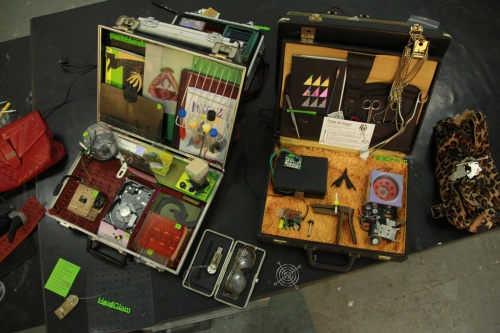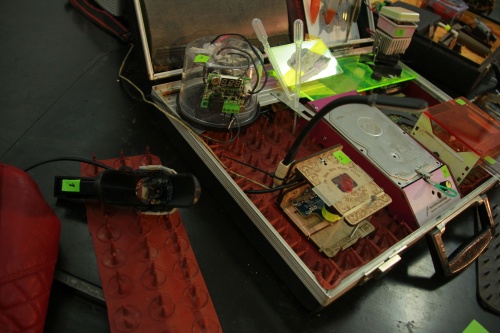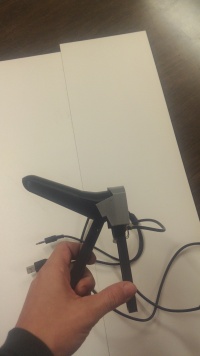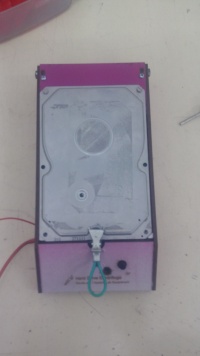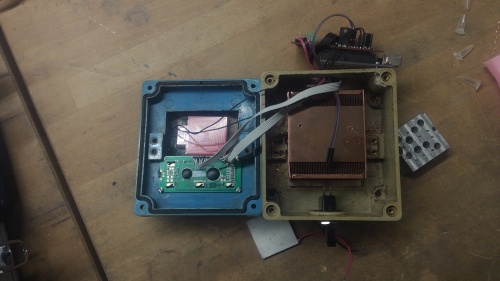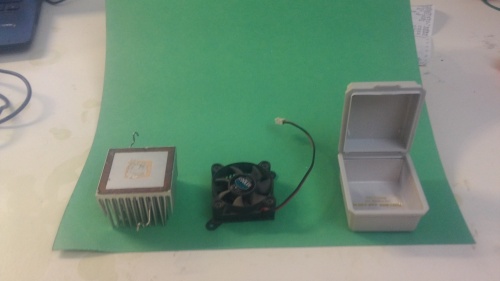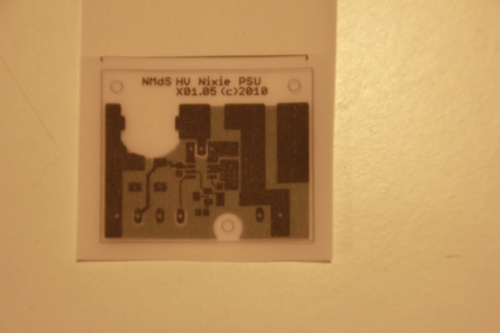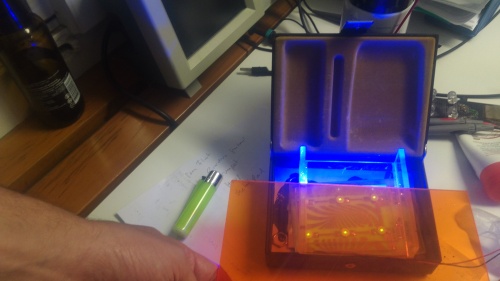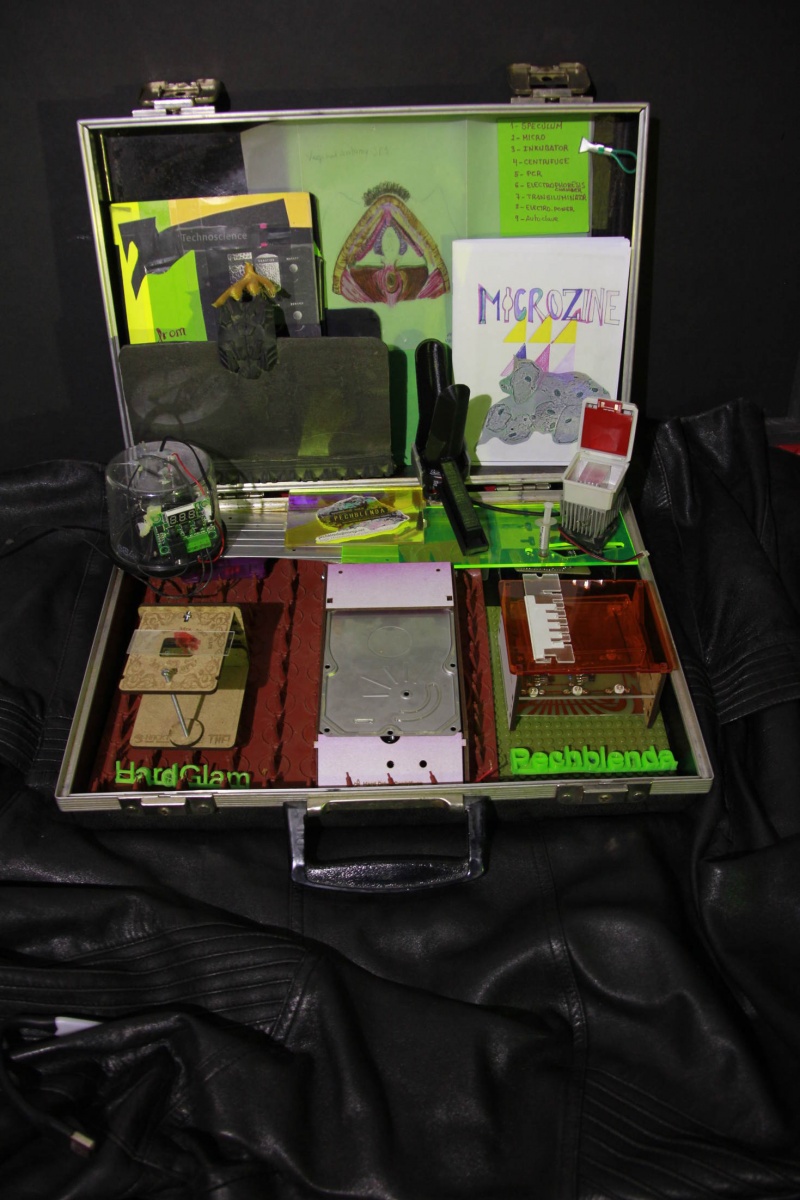Prototyp-ome autoresidence
Contenido
- 1 prototyp_ome autoresidence
- 2 Dispositivos y herramientas del laboratorio móvil BioTRANSlab
- 3 * 1 Speculum
- 4 * 2 Microscopio Mary ward
- 5 * 3 Inkubator
- 6 * 4 Centrifuga
- 7 * 5 PCR Reacción en cadena de la polimerasa NinjaPCR HARDGLAM
- 8 * 6 Cámara de Elektroforesis
- 9 *7 TRANS.iluminator
- 10 * 8 Autoclave
- 11 * BIOtranslab
- 12 Noticias / Articulos relacionados
prototyp_ome autoresidence
Biotranslab: proceso de desarrollo e implementación del Laboratorio Móvil basado en Mobile labs hackaton Lubliana 2013 link
Dispositivos y herramientas del laboratorio móvil BioTRANSlab
* 1 Speculum
algunas imágenes realizadas durante 2015-16 con spcelums de usar y tirar https://hackteria.org/wiki/*_Open_speculations
- el SPECULUM es una herramienta ginecológica que se usa para tener acceso al interior de la vagina y con ello poder observar el cervix, también es usado para poder recoger muestras de flujo y de células epiteliales, estas células epiteliales serán raspadas cuidadosamente sobre un slide de microscopia y el microscopio nos permitirá observar el estado de las células dependiendo de la conformación de su núcleo y citoplasma.
aquí puedes descargarte el diseño de Urs [1]
* 2 Microscopio Mary ward
para la réplica del microscopio se ha realizado un fanzine que es descargarte en formato pdf aquí "de la BioPolitica al BioTransLab" muestra el How to ( hazlo tu mismx ) para la realización de un microscopio [2]
Hay un segundo Fanzine llamado Microzine que te permite descubrir tu microbiota vaginal y hacer uso de técnicas low cost para detectar microorganismos a veces colonizadores descárgalo aquí [3]
Técnica de detención de Cándida low cost con un químico de fácil acceso Hidróxido potásico KOH [4]
* 3 Inkubator
Una inkubadora viene a ser cualquier recipiente, caja o cámara estanca que puede mantener una temperatura fija a lo largo del tiempo. Por lo general funcionan con un elemento térmico que proporciona calor para poder tener la temperatura deseada. El elemento térmico suele ser :
- una peltier
- una bombilla tunsteno
- una resistencia
El ejemplo desarrollado para el Maletín Biotranslab esta basado en el circuito electrónico del Fermento_one.
low-cost incubator from parts commonly available. Incubators are devices allowing to adjust and keep environmental conditions such as temperature, humidity and CO2 concentration. They are commonly used to grow microbiological cultures, hatch chicken, or also to care for premature newborn infants. Unlike lab-grade incubators, the design we are using only allows to maintain constant temperature (it only has a heating element). In the framework of BioDesign for the Real World, such an incubator could be used for the following. -Prepare cell or bacteria cultures for analysis (e.g. E. Coli contamination), to distinguish fecal coliform bacteria, which will survive at 44oC, vs total coliform bacteria at 35oC. -Prepare fermented food (yoghurt, natto, tempe, etc.) as an introduction to DIY biology. Modern biology relies on increasingly complicated instruments and machines. This makes it practically impossible for anyone outside a university or company lab to have access to this technology. By creating open, easily replicable designs using freely available parts, we hope to bring the technology and the knowledge out of the lab to be used by communities. Location and audience To reflect this out-of-the-lab philosophy, the workshop was held at Atelier Hirokouri in downtown Lausanne (instead of EPFL campus). We were two instructors (Sachiko and Robin) and eight attendees, most of them from a graduate biology/life science background. Incubator design The incubator design is a simple one. It relies on a single heating element (a standard E27 light bulb), a temperature sensor (LM61CIZ), and a control board that controls how long the light bulb is on/off according to the sensor reading. For the container, we use a Styrofoam box such as those used for food (fish, meat, etc.) or biological sample. We salvaged the boxes from the biology department garbage, but such boxes can also be found in fish markets, supermarkets, or bought new in a shop.
to make your own one check here the complete info
para el BiotransLab se ha realizado una escala de la cámara incubadora por cuestiones de eficiencia energética y espacio reducido y se ha sustituido la bombilla por una red de resistencias apta para 12V, la forma circular es idónea para las petri dishes más comunes.
* 4 Centrifuga
GynepunkFuge how to ( hazlo tu mismo ) https://www.hackteria.org/wiki/Gynepunkfuge
modelo específico de el Biotranslab gaudi labs centrifuge [7] how to : [www.gaudi.ch/GaudiLabs/wp-content/uploads/HardDriveCentri_laser.pdf]
A centrifuge is a rotating wheel with very high rotational speed (RPM) and a strong body protecting the people around from the energy of the fast moving parts. Substances are loaded into the vial holders at the edge of the fast spinning wheel and are separate along their different densities. Fast spinning computer hard drives in a solid aluminium housing are perfect for making small DIY centrifuges.
How To
The design is based on conventional 3.5″ desktop hard drive. You usually need a small torx screw driver to open them. The disks are removed and replaced by a laser cut acrylic tube holder. Only small centrifuge tubes (0.5 ml) can be used with this kind of design. Make sure the tube holder fits well on the shaft of the motor and fix it back with the original down holder. The parts for the housing provides a stable stand and allow easy opening of the lid. To drive the motor replace the electronics by a ESC brushless motor driver for RC cars. To control the speed use a so call “Servo Tester” unit that fits well with the motor driver. Link [8]
* 5 PCR Reacción en cadena de la polimerasa NinjaPCR HARDGLAM
En el siguiente link puedes aceder a información completa y detallada de los usos de una PCR [9]
accede a la bitacora para ver el proceso [10]
Siguiendo los pasos de la Ninja PCR he realizado esta glamurosa versión de la PCR [11]
una segunda versión se realizó en 2017 aquí el link [12]
* 6 Cámara de Elektroforesis
Una electrophoresis chamber es una cámara en la que se va a realizar un proceso de electrólisis, en este caso para hacer correr el ADN a través de un Gel. su realización puede simplificarse mucho y puede ser suficiente con usar una cajetilla de cartas de <Virisca como la de la imagen a la que le haremos dos agujeritos de el mismo lado y en posición opuesta para poder colocar los electrodos negativo el Carbón, en este caso usamos una mina de lápiz y un pedazo de platino fino para la correcta reacción de electroforesis.
Así mismo lleva un sistema que hace pasar corriente elevada por los electodos para mover el ADN, ya que esta fuentes de alimentación son caras en el mercado se decide copiar un circuito de y tener entonces nuestra fuente de alimentación, aquí les dejo un link que explica paso a paso el como construirlo.
*7 TRANS.iluminator
* 8 Autoclave
* BIOtranslab
3 * 1 Speculum 4 * 2 Microscopio Mary ward 5 * 3 Inkubator 6 * 4 Centrifuga 7 * 5 PCR Reacción en cadena de la polimerasa NinjaPCR HARDGLAM 8 * 6 Cámara de Elektroforesis 9 *7 TRANS.iluminator 10 * 8 Autoclave 11 * BIOtranslab
Ha sido hermoso encontrar a personas como Urs y Sachiko que han sabido plasmar de manera tan amorosa lo que conlleva para ellxs/nosotrxs el hecho de hacer lab como un acto de amor aquí lo copio porque me enamora
A Lab is a place to labor, experiment, research and share — this could be anywhere. There is no labor, experiment, research nor sharing without the people. It is not a museum for journalists. A Lab is first the person and first+ the people. Start a Lab small in a box, suitcase, backpack, picnic basket and take it with you. A Mobile Lab allows you to go to people, and not wait for the others to come. We have always been biohackers.
— cheese, kimchi, tempeh
The kitchen is not a far cry from the ideal bio Lab. In traditional houses, the kitchen faces north, not to spoil the food. There is a water and heat source, solid non-porous work surfaces, fridge and freezer or equivalent for long-term storage, utensils, garbage bins.
— wine, bouillon, agar
In entry-level biology, taste and eat in the lab. If you can not eat what you are cooking, it’s probably too dangerous for a public lab [1]. Many chemicals and reagents can be found in the pharmacy, garden center, hardware, pet and grocery stores. It is easier and safer. Get to know your local stores. Build a relationship with the pharmacist, not the chain store kind. If you have to order chemicals and biological supplies, the pharmacist is your friend. If you start to order reagents yourself, start by ordering something innocuous. This will allow you to be a registered customer without raising red flags. Then graduate to ordering the harder stuff. Get two fridges: eat and not eat. Label well, with understandable words, because eating is best when shared with others, and you don’t want to kill your friends who stop by. Build it Open it Hack it and Own it.
Biology is about living things. Make a home for your living thing in the BioLab. Be prepared to take care of your new pets day and night. Build your Lab around your pets and projects, one thing at a time.
The projects will attract a community. Then let the community build the Lab, don’t build a lab for the community — or you get a lot of stuff that is never used. The Lab is the people and the projects. Make the Lab environment and use and share it. This will shape your Lab to evolve and evolve with your projects.
Spend some time in the local flea market. Go to your local recycling center (déchetterie). Go dumpster-diving. Get to know people who work in institutional laboratories. Visit them frequently and don’t be shy to ask for some materials. Dentists, opticians/optometrists and doctors have amazing materials. Go get your teeth cleaned and a go for a check-up. Make your own lab equipment. Use a pressure cooker as an autoclave, a hard disk as a desktop centrifuge, a styrofoam box and a light bulb and make an incubator. Print your own micropipettor, or buy some off the internet. Microbiology started with the discovery of the microscope. Make your own webcam microscope. Make your own PCR machine with an OpenPCR kit. You will become an expert in what it is that you are doing. Evolve what is out there. Second-hand equipment bought from the internet can be old, heavy, big, energy consuming and not cool. Know what can be built yourself, and when to get the equipment even if old [2]. Sometimes oldskool is the best - easier to fix.
Make it yours — mix up the “lab aesthetic” and your every-day objects. Pick a color, paint a wall. Play with lights. But still a Lab is a place to labor, to try things out and make mistakes. Make sure it is inviting to make a big mess. Mixing wet stuff with electronics is not a crime. It’s cool. As long as you use small batteries you are on the safe side. High voltage can kill elephants. And box, label, box, label, label so you can find your stuff.
Know how to throw things out. Batteries are batteries. Electronic waste is electronic waste. Blades, syringes are sharps. Glass is glass. PET is PET. If it is something that can grow forgotten in a corner of your fridge, it is regular waste. If in doubt, autoclave it. Separate materials in separate waste bins. Separate concentrated acids and bases. If you have solvents, better to ventilate. Halogenated solvents should be separate from other solvents. Look up material safety data sheets (MSDS), and learn what not to freak out about them. Know what your local recycling center is ready to receive. Think about what you are using. Don’t throw everything down the drain or in the trash. For simple experiments, washing and reusing plastic tips and petridishes makes sense. Find glass petridishes so they can be cleaned and sterilized. We are not saving the world, we just try to fix it, tweak it, hack it — we have time to do some kitchen cleaning.
Biology is about living things. Biology takes time. Biology takes iteration. Like anything else, biology takes practice. Observe your Lab pets, love them, take a look at them under the microscope. Spend a long time observing the amazing small things that inhabit our planet. The rest are just dinosaurs and their relatives.
Did we mention Biology stinks? You are never alone.
If you don’t know how to do something just try — or ask. If you don’t know to whom to ask, just talk to everyone about what you plan to do — in person, online. Learn from the community. Give to the community. The network and open sharing of knowledge is our unique strength.
You will find community in local citizen science groups. You will find communities self-identified as biohackers and DIYbio-ers. The craziest and most experienced DIY biohackers are probably still under-cover. Sitting in an inconspicuous Lab, growing mushrooms, spiders, snakes, ants, exotic fish, artificial tissue…
Enjoy Lab Making, and hope to hear from you, soon.
Footnotes
[1] Community outreach, going to elementary schools, open house days…
[2] A centrifuge is a heavy and solid container that protects you from something rotating inside — if that something rotating is heavy, it is better to use second-hand, balanced centrifuge rather than a DIY one.
Noticias / Articulos relacionados
- Open-hardware’ pioneers push for low-cost lab kit
- Open Surgery
- 3D printed medical device detects anemia within seconds
- Portable microfluidic tool successfully diagnoses Ebola
- Hacking the body—the scientific counter-culture of the DIYbio movement
- Mexicana crea sensor que detecta papiloma humano de inmediato “Nanotubos de carbón de pared sencilla como sustrato de inmovilización de ADN para biosensores electroquímicos del VPH”
- Crean un anillo vaginal que protege del VIH y del herpes
- Male Contraception Ultrasound
- Low-cost design makes ultrasound imaging affordable to the world
- Lab-on-an-egg-beater
Category:
Pechblenda
